
Chapin, popularly known as the "Capital of Lake Murray", is a small lake town located at the northern tip of Lexington County, South Carolina, United States. Lake Murray separates Chapin from the rest of Lexington County. The population of Chapin was 1,445 according to the 2010 census, and an estimated 1,633 in 2019.
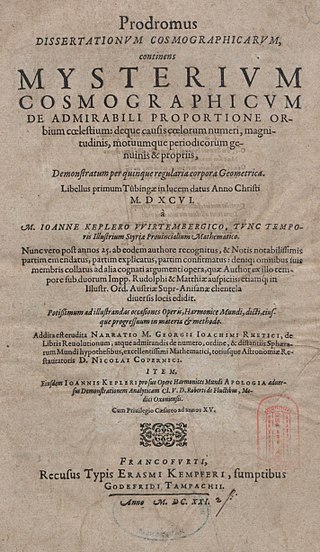
Mysterium Cosmographicum is an astronomy book by the German astronomer Johannes Kepler, published at Tübingen in late 1596 and in a second edition in 1621. Kepler proposed that the distance relationships between the six planets known at that time could be understood in terms of the five Platonic solids, enclosed within a sphere that represented the orbit of Saturn.

Chapin School is an all-girls independent day school in New York City's Upper East Side neighborhood in Manhattan.

Strongyles, or alternatively, strongyls, are nematode worms of the family Strongylidae, order Strongylida. They are often parasitic in the gastrointestinal tract of mammals, especially grazers such as sheep, cattle, and horses.

Walther Hermann Richard Horn was a German physician and entomologist who specialised in beetles (Coleoptera), particularly the tiger beetles. He became the founding director of the German entomological institute where he collaborated with entomologists around the world. He is not to be confused with the American entomologist George Henry Horn who also studied Coleoptera.

Maurice Pic was a French entomologist who specialised in Coleoptera. He contributed to Mary-Louis Fauconnet's Catalogue raisonné des coléoptères de Saône-et-Loire and wrote many short papers, many in L'Échange, Revue Linnéenne describing world beetles. His most important work was for Sigmund Schenkling's still very relevant Coleopterorum Catalogus.

Haliplus is a genus of crawling water beetles in the family Haliplidae. There are at least 180 described species in Haliplus. They are found worldwide, except for Antarctica, living among algae and aquatic vegetation at edges of ponds, lakes, and streams. They range in size from 1.75 to 5 mm.

Insektenbörse was a German entomology magazine established in 1884. It was renamed Entomologisches Wochenblatt in 1907–1908 and renamed again Entomologische Rundschau in 1909–1939. Beginning with volume 26 the journal was published by Alfred Kernen Verlag, Stuttgart, Germany. Insekten-Börse was also issued at various times as a trade supplement to Entomologische Zeitschrift.
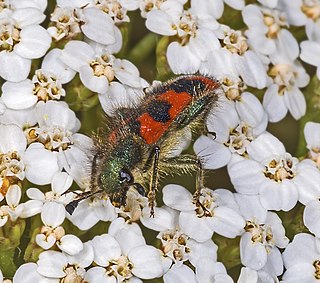
Trichodes is a genus of checkered beetle belonging to the family Cleridae, subfamily Clerinae.
In ancient Greek religion and mythology, Melia, a daughter of the Titan Oceanus, was the consort of Apollo, and the mother, by Apollo, of the Theban hero and prophet Tenerus. She was also the mother of Ismenus, god of the Theban river of the same name. Melia was an important cult figure at Thebes. She was worshipped at the Ismenion, the Temple of Apollo at Thebes, and was associated with a nearby spring.

Enoclerus is a genus of checkered beetles in the subfamily Clerinae.

Tillinae is a subfamily of beetles in the family Cleridae, the checkered beetles.

Isohydnocera is a genus of checkered beetles in the family Cleridae. There are about 14 described species in Isohydnocera.

Panscopus is a genus of broad-nosed weevils in the beetle family Curculionidae. There are more than 30 described species in Panscopus, found in North America.

Phyllobaenus is a genus of checkered beetles in the family Cleridae. There are at least 60 described species in Phyllobaenus.
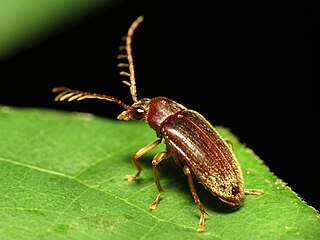
Ptilodactyla is a genus of toe-winged beetles in the family Ptilodactylidae. There are more than 30 described species in Ptilodactyla.
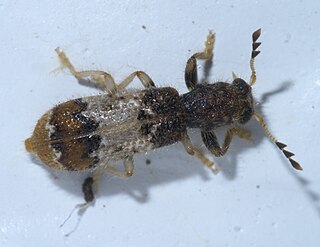
Pelonium is a genus of checkered beetles in the family Cleridae. There are about 19 described species in Pelonium.

Trachodes is a genus of true weevils in the family of beetles known as Curculionidae. There are at least 30 described species in Trachodes.
In ancient Greek religion and mythology, the Theban hero Tenerus was the son and prophet of Apollo. His mother was Melia, a daughter of the Titan Oceanus.
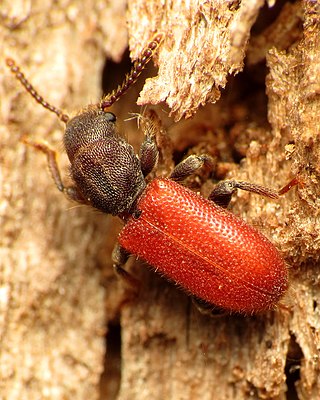
Thanerocleridae is a family of beetles belonging to the superfamily Cleroidea. It was formerly considered a subfamily of Cleridae, but was recently elevated to the rank of family. The family has 36 living species in 10 genera, which are found globally, mostly in low-latitude tropical regions, though the genus Zenodosus is found in temperate North America. Thaneroclerid species are likely all predatory both in adult and larval stages. They target small fungus and wood associated beetles, and are generally found in places where such beetles are likely to be found, typically tree associated habitats such as under bark, though some species occur in other locations such as termite nests.



















